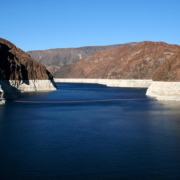States Sign Short-Term Colorado River Drought Plan, But Global Warming Looms Over Long-Term Solutions
The Colorado River just got a boost that’s likely to prevent its depleted reservoirs from bottoming out, at least for the next several years. Representatives of seven Western states and the federal government signed a landmark deal on Monday laying out potential cuts in water deliveries through 2026 to reduce the risks of the river’s reservoirs hitting critically low levels. Yet even as they celebrated the deal’s completion on a terrace overlooking Hoover Dam and drought-stricken Lake Mead, state and federal water officials acknowledged that tougher negotiations lie ahead



